A vast majority of small businesses are missing the benefits of AI-powered CRMs that can help increase productivity and sales. See how with these CRM statistics.
32 B2B Sales Statistics You Must Know in 2024
This article is part of a larger series on Sales Management.
Business-to-business (B2B) sales involve selling products or services to other businesses, associations, or nonprofit organizations. To prepare for this environment using real-life insights, here are 32 B2B sales statistics you should know, plus their key takeaways. These include stats on sales processes and strategies, common lead generation practices, prospecting, sales technology, marketing, and training.
Highlights
- Artificial intelligence (AI) tools have exponentially gained popularity, particularly in prospecting, sales processes, and marketing.
- Sales reps want to focus more on selling than doing more administrative tasks.
- Customer relationship management (CRM) software continues to play an important role in helping sales teams close more deals.
- Webinars and referrals remain the top methods for lead generation.
B2B Statistics on Sales Process & Strategies
These B2B statistics illustrate a typical B2B buying journey, what it takes to get B2B leads through the sales pipeline, and why they buy from one firm over another. It includes B2B buyer journey statistics, insights on conversion rates from stage to stage, and specific sales activities sales reps need to understand to close the deal.
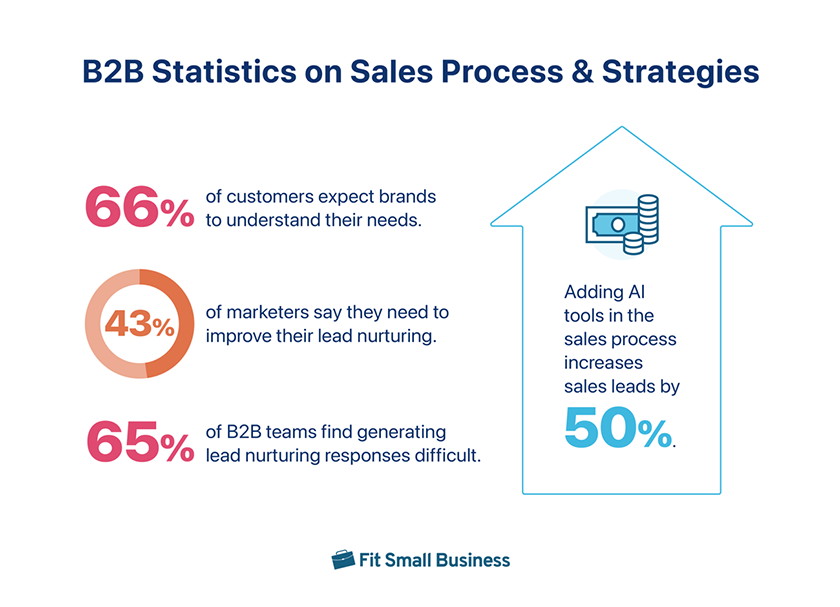
1. Adding AI tools in the sales process increases sales leads by 50%.
Takeaway: Sales teams of business-to-business (B2B) companies can use AI to handle repetitive tasks, such as recording customer data and logging sales team activities. That way, they can focus more on selling and improving your sales process. Businesses can save $89.07 billion a year if salespeople use AI to complete non-sales-related tasks, like data entry and admin work, which take up 70% of their time.
(Source: Ringover)
2. 66% of customers expect brands to understand their needs.
Takeaway: Customers love to patronize brands that offer cost savings and helpful recommendations. They face various pain points in every sales funnel stage, such as understanding the features and benefits of solutions companies offer. If sales teams have the right data, they will know the next best steps and help prospects make more informed buying decisions to resolve their problems, boosting customer retention and sales.
(Source: HubSpot)
3. 43% of marketers say they need to improve their lead nurturing.
Takeaway: Success metrics for lead nurturing programs have experienced a minor change since the previous year, with more marketers perceiving the need for improvement. About 31% of the respondents gave an average rating to their strategies, indicating more push to attain their goals. Email click-through rates and revenue are the top sales success metrics that will help you determine if you are on the right track to achieving the goals you have set for your lead nurturing program.
(Source: Demand Gen Report)
4. 65% of B2B teams find generating lead nurturing responses difficult.
Takeaway: One of the issues that affect the responses from lead nurturing initiatives is the difficulty in building the right campaign workflows. Modern buyers also want to navigate their purchasing process on their own. Lead nurturing campaigns, when properly executed, can help segment prospects based on interests, drive better response rates, and generate warmer leads.
(Source: Demand Gen Report)
Pro tip: Did you know your customer relationship management (CRM) system can automate email nurturing activities? Popular tools like HubSpot include email design and deployment features that help send out mass emails to leads stored in your CRM system. The capabilities include templates for creating sales emails and customizable steps, automated for when or in what circumstance the next message goes out.
B2B Sales Training & Coaching Statistics
Sales training is more critical in B2B sales than business-to-consumer (B2C) because most of the sales process involves direct interactions with a lead. Team members also need some technical knowledge regarding their products or services and sales skills to help clients navigate solutions—demanding more training. These B2B statistics show the true impact of sales training and how coaching is used for top business-to-business companies.
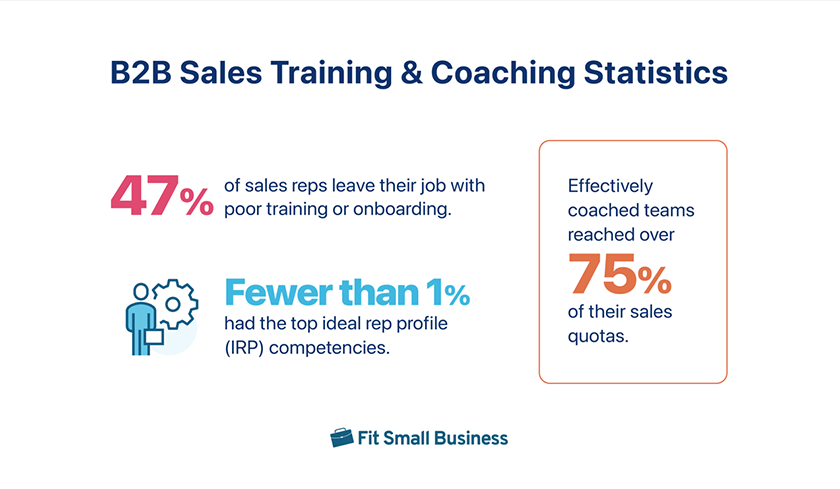
5. 47% of sales reps leave their job with poor training or onboarding.
Takeaway: Many reps often hate their initial training process as it causes them to suffer from boredom when they’re eager to get out and sell. It turns out, however, that almost half will actually leave their firm if they had a bad experience. That said, consider avoiding traditional classroom-style training seminars or standardized tutorials. Instead, try more hands-on training that has a higher engagement, such as running simulated scenarios and job shadowing veteran reps.
(Source: Spekit)
6. Effectively coached teams reached over 75% of their sales quotas.
Takeaway: Sales management leadership includes building and onboarding a sales team, motivating reps for peak performance, ensuring individuals are meeting their quotas, and enabling success by providing the right resources. If you want your team to reach or exceed your sales quotas, consider implementing regular sales coaching to improve pitching, negotiation, lead nurturing, and relevant deal-closing skills.
(Source: Mindtickle)
7. Fewer than 1% had the top ideal rep profile (IRP) competencies.
Takeaway: Much like how an ideal customer profile (ICP) details the key qualities of a good prospect, the IRP documents the top competencies that a sales rep must have to be successful. IRPs are as important as ideal customer profiles (ICPs) because they guide your reps toward success.
(Source: Mindtickle)
Pro tip: Read our guide to the best sales training programs that can help you maximize your team’s performance. One of the top general sales programs is IMPACT Sales Team Training designed by The Brooks Group. This class teaches reps and managers how to better identify prospects and communicate with them more effectively.
B2B Statistics in Marketing & Sales Content
Content marketing has proven to be a popular and effective tactic for B2B sales and marketing. These B2B online sales statistics outline how thought leadership through articles, videos, podcasts, and presentations helps generate leads and convert them into closed deals.

8. 14% use generative artificial intelligence (AI) tools for sales.
Takeaway: Marketers and sales reps can leverage generative AI tools to learn new concepts and strategies quickly. AI-powered training software has automation, advanced search, and analytics capabilities, providing accurate, lightning-fast, knowledge-based marketing and sales enablement data.
(Source: McKinsey)
9. 53% of tech leaders use generative AI for marketing & advertising.
Takeaway: Tech business leaders use generative AI beyond ChatGPT. However, only a few are using these tools extensively. One reason for this is that a majority of B2B organizations don’t have solid ChatGPT usage policies, causing restrictions and uncertainties. But the top use case in utilizing this technology is data analysis and prediction, which are also the most-sought AI capabilities in customer relationship management (CRM) software solutions today.
(Source: Gartner)
10. Half of all customer engagement is generated by 10% of content.
Takeaway: Churning out more content does not necessarily lead to more sales. Moreover, not all types of content generate the same level of customer engagement. Focus on improving the quality of your content rather than the quantity to generate more engagement.
(Source: Mindtickle)
11. Building the right campaign workflows remains a big challenge.
Takeaway: Other top difficulties B2B marketers encounter are developing targeted content, a lack of follow-up, insufficient lead nurturing best practice insights, and declining response rates. CRM systems with a power dialer, such as Freshsales, enable sales agents to reach more leads, make follow-up calls easier, and streamline your whole sales process.
(Source: Demand Gen Report)
12. 57% of B2B teams say curating the right content is tricky.
Takeaway: The proliferation of freelance writers and the development of generative AI tools resolved the previous struggle of generating adequate content. Today, the challenge is creating the best content. Sales teams must carefully scrutinize the content they will be publishing to ensure accuracy, relevancy, and effectiveness in attaining their goals.
(Source: Content Marketing Institute)
13. 45% find aligning content marketing & sales efforts challenging.
Takeaway: Marketing and sales teams must work together to move prospects to the bottom of the sales funnel. A centralized platform with robust collaboration and outreach tools can help both teams assist leads, from creating initial brand awareness to guiding leads to make informed buying decisions.
(Source: Content Marketing Institute)
Pro tip: Finding a CRM that also lets users create and distribute content is valuable. Luckily, HubSpot is a sales, marketing, and content management system (CMS) built into one platform. Teams can design websites, write and publish blog posts, and even host on-demand video content through the content management system (CMS) module.
B2B Sales Statistics on Lead Generation
These B2B sales trends outline how and where businesses find their potential business customers—otherwise known as B2B lead generation. Whether it be content marketing, referrals, cold calling, or networking events, lead generation is a critical step in the sales process for keeping the pipeline full of opportunities.
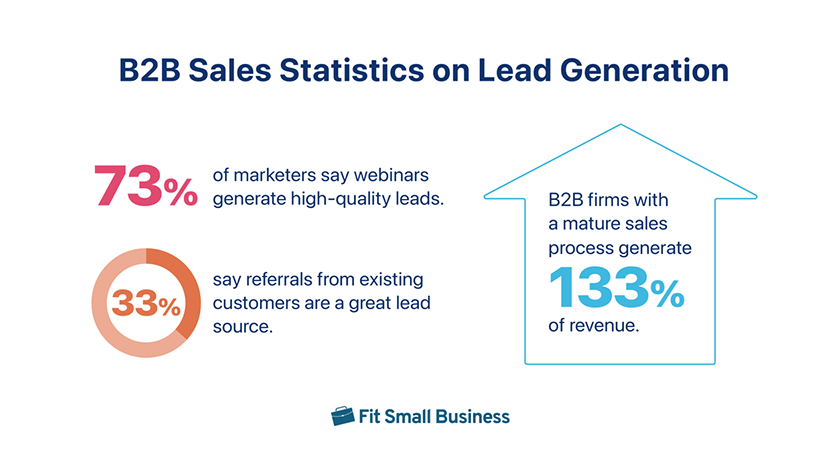
14. 73% of marketers say webinars generate high-quality leads.
Takeaway: Much of B2B selling is getting in front of the right audiences and prospects. There is no better way to do that than hosting webinars for an entire market segment. You can cover challenges and best practices specific to that target market and then tease how your product or service is the ideal solution. This is the structure of most B2B webinars, which appear to be solid channels for generating new, qualified leads.
(Source: Startup Bonsai)
15. 33% say referrals from existing customers are a great lead source.
Takeaway: Many people assume referral programs are only for B2C businesses such as retailers or ecommerce stores. However, the B2B ecommerce statistics above tell us objectives can easily cross into the B2B industry. Customers use referrals as reliable sources of information—helping build trust with a brand much sooner. The net cost of a referral is cheaper and those leads tend to have higher customer conversion rates.
(Source: HubSpot)
16. B2B firms with a mature sales process generate 133% of revenue.
Takeaway: A “mature” lead generation process refers to having a standardized, methodical approach that employs best practices and automation in the mix. In other words, it’s a repeatable process for each lead that comes in the pipeline. It’s clear that in a structured system with automated lead assignment, data entry, and call scheduling, opportunities and tasks don’t slip through the cracks—ultimately bringing in more revenue.
(Source: Intellistart)
Pro tip: A CRM system like HubSpot lets users customize and embed online forms on their websites. From there, site visitors can submit their information, automatically create new lead records in the CRM system, and notify sales reps. Read our expert HubSpot CRM review to learn more.
B2B Sales Statistics for Prospecting & Lead Qualification
Lead qualification determines if leads fit your target customer profiles and prioritizes the best pipeline opportunities. It’s an essential sales step that requires prospect research before making initial contact. It also involves communicating with a new lead to determine their need for your product or service and their capability to make the purchase. These sales statistics outline the challenges and importance of thorough prospecting and qualification.

17. 68% of leads love the speed of chatbots when answering queries.
Takeaway: Chatbots can answer general, predetermined questions quickly. AI-powered chatbots employ machine learning, which means they can adapt and search for information to answer questions lightning-fast and accurately. Sales teams can use AI chatbots and CRMs to quickly respond to potential leads’ queries, moving them faster to the bottom of the sales funnel.
(Source: Userlike)
18. 64% of salespeople use AI tools to personalize prospecting efforts.
Takeaway: With the advancement of AI, sales teams can benefit from complex AI algorithms to tailor product recommendations and qualify and prioritize leads. For instance, sales managers can create workflow automation rules for sales reps to follow based on customer personas. Moreover, predictive lead scoring software identifies the highest-quality pipeline leads.
(Source: HubSpot)
19. Successful sales reps spend 38 minutes on a sales discovery call.
Takeaway: Leads tend to lack focus and feel dragged if the sales discovery call is too long. On the other hand, spending too little time on a discovery call may lead to unanswered questions and frustration. Keep your sales discovery call time frame within 38 minutes. If you can’t do it, find out who’s taking the most time—the sales rep or the lead—and determine the call structure and outcome to rule out the time gap.
(Source: Mindtickle)
20. 37% of consumers received AI-powered chatbot assistance.
Takeaway: This data shows how AI is reshaping customer interactions in the financial sector, which also applies to B2B-like technology. B2B companies deploy chatbots as a part of their customer service. AI communication tools are perceived as a cost-effective alternative and complementary service to human customer support. For this reason, many small businesses also deploy chatbot capabilities into their CRMs to benefit from this technology.
(Source: Consumer Financial Protection Bureau)
Pro tip: Many sales reps are unaware they can automate one of the most tedious parts of cold calling—finding contact data and dialing. Freshcaller is the built-in phone tool of the Freshsales CRM system. It comes with power dialing features that let users insert a preset call list, which is typically made up of contacts stored in the CRM. It then auto-dials down the list for you as the previous call concludes.
21. 26% better lead quality is a top sales-marketing alignment benefit.
Takeaway: Because so much time is devoted in B2B sales to pushing a deal through the pipeline, avoiding poor-quality opportunities helps improve productivity. Marketers often use campaigns to generate leads and then pass them off to reps to finish the sale. It’s clear that keeping both sales and marketing teams in sync using defined customer profiles, qualification criteria, and technology systems improves the quality of the leads generated.
(Source: HubSpot)
Pro tip: Lead qualification is already challenging enough. Invest in a CRM that can automate qualification tasks through lead scoring tools. Lead scoring involves assigning points to deals or contacts based on preset profile attributes and activities such as emails opened or files downloaded.
B2B Sales Productivity Statistics
Ever wondered how reps are spending their time and why certain teams are more efficient than others? These B2B sales statistics for productivity cover some of the best sales enablement solutions and the day-to-day work of B2B salespeople.
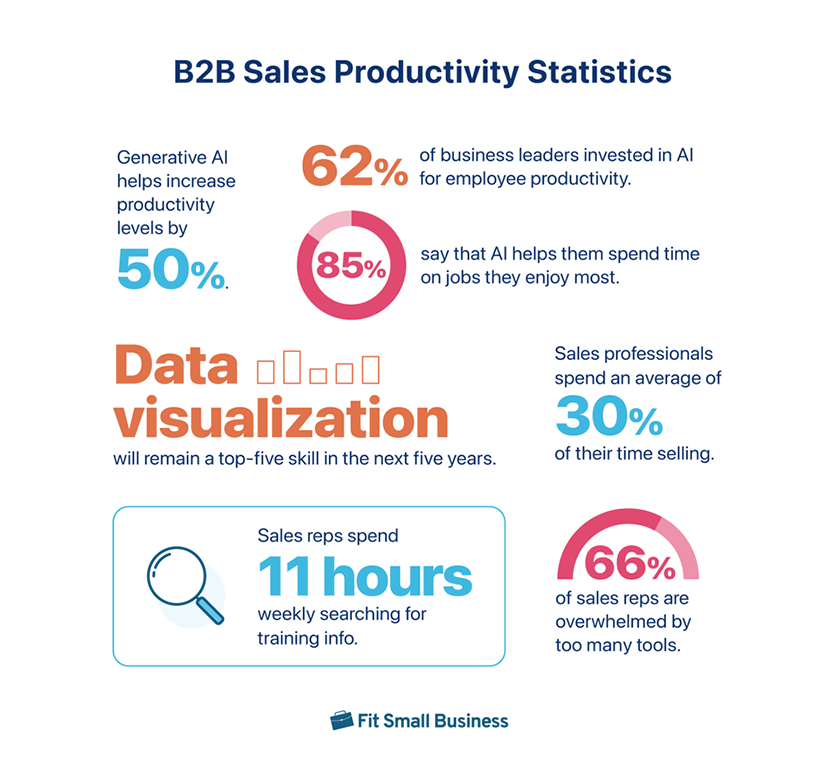
22. Generative AI helps increase productivity levels by 50%.
Takeaway: Like computer programmers and copywriters, sales reps can increase productivity levels by embracing artificial intelligence. AI tools will continue to advance in 2024 and beyond because sales are getting more complex. AI-powered digital app integrations and workflow automation play a vital role in product information sharing and configuring, lead generation and prioritization, and order placement.
(Source: Harvard Business Review)
23. 66% of sales reps are overwhelmed by too many tools.
Takeaway: Sales teams usually use 10 tools, with sales report capabilities, a CRM system, account and contact management, mobile sales apps, and sales forecasting tools as the top five in closing deals. However, too many tools can be inefficient and costly. Using an all-in-one CRM platform can help resolve this problem.
(Source: Salesforce)
24. 62% of business leaders invested in AI for employee productivity.
Takeaway: Businesses with AI investments reported a positive return on investment (ROI), and leaders say that AI tools make their employees more productive. Small businesses can also invest in CRMs with AI capabilities for order and sales performance tracking, customer support, and other business operations.
(Source: HubSpot)
25. Data visualization will remain a top-five skill in the next five years.
Takeaway: Sales operations (SalesOps) professionals dedicate most of their time to supporting non-sales functions, according to this Gartner survey. Companies need SalesOps with strong B2B sales data visualization and analytical skills. These hard skills ensure cross-functional alignment and productivity as they support supply chain, finance, human resources (HR), information technology (IT), and enterprise analytics.
(Source: Gartner)
26. 85% say that AI helps them spend time on jobs they enjoy most.
Takeaway: Small businesses can also win more sales by allowing their employees to enjoy what they are actually hired for—selling. Business owners can upgrade their outdated systems by choosing the best AI CRMs with advanced prospecting, analytics, reporting, and workflow automation. When your sales team uses a robust AI CRM, you can spend more time talking to your prospects to win more sales.
(Source: HubSpot)
27. Sales reps spend 11 hours weekly searching for training info.
Takeaway: The survey for these B2B stats showed reps spend too much time trying to get answers about their sales technology, operational processes, or resources. All these are aspects that should be taught during sales training and onboarding, not while the rep is in the full swing of their job. The lesson: prioritize sales training early on so reps don’t waste their time later.
(Source: Spekit)
28. Sales professionals spend an average of 30% of their time selling.
Takeaway: B2B sales success is all about building and maintaining relationships with decision-makers. However, it’s tough to produce revenue when 70% of a rep’s time is spent on administrative tasks like researching, appointment scheduling, proposal generation, and data entry.
These tasks can often be automated or outsourced. For example, teams can purchase lead lists from outside vendors that filter to meet company size, industry, and even technology stack requirements rather than research themselves.
(Source: LinkedIn)
B2B Sales Technology Statistics
Sales technology such as CRMs, sales automation software, and data analytics tools help teams streamline and collaborate on workflows. The following B2B sales analytics data dive into the types of sales enablement technology and digital marketing B2B organizations are currently using in their software arsenal.
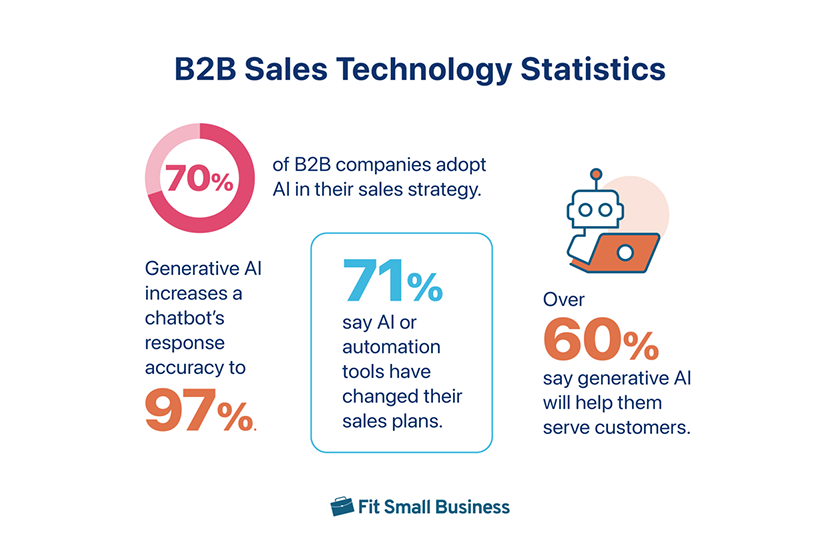
29. 70% of B2B companies adopt AI in their sales strategy.
Takeaway: B2B organizations see the big potential of AI in sales. However, sales teams need to explore more about this technology to learn how they can incorporate AI into their day-to-day activities. Many CRM solutions have AI capabilities, saving sales reps plenty of time by eliminating manual customer data entry, activity logging, and other administrative work.
(Source: Gitnux)
30. Over 60% say generative AI will help them serve customers.
Takeaway: In the past, return on investment (ROI) was measured by training courses completed, and not if sales members could apply their learnings to close deals. AI-powered sales enablement tools enable sales managers to evaluate and adjust programs in real time by measuring pipeline generation, win rates, average customer value (ACV) value, and customer satisfaction.
(Source: Salesforce)
31. 71% say AI or automation tools have changed their sales plans.
Takeaway: About 60% of respondents also acknowledged the importance of AI tools in sales strategizing. The three most common use cases for AI or automation in sales include automating manual tasks, offering data-driven insights, and writing prospect outreach messages or sales content. Your sales team can use AI to meet your monthly or quarterly sales quotas by creating strategic sales plans.
(Source: HubSpot)
32. Generative AI increases a chatbot’s response accuracy to 97%.
Takeaway: Generative AI’s potential as a chatbot has reduced errors and improved efficiency for an insurance company. The same concept applies when adopting AI technology for B2B sales. AI chatbots provide accurate answers in the form of frequently asked questions (FAQs) and personalized answers by addressing the prospect by their first name and product recommendations based on gathered analytics data.
(Source: Cognizant)
Bottom Line
B2B selling consists of a longer, more complex sales process—requiring more training and technology resources to produce solid revenue numbers. These lead management and B2B online sales statistics and examples of sales technology products will help you better navigate the space. Use these real-life insights to generate more quality leads, improve sales pipeline health, and maximize your reps’ productivity.